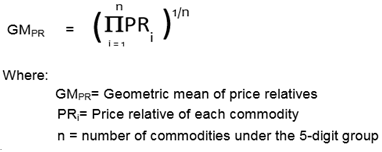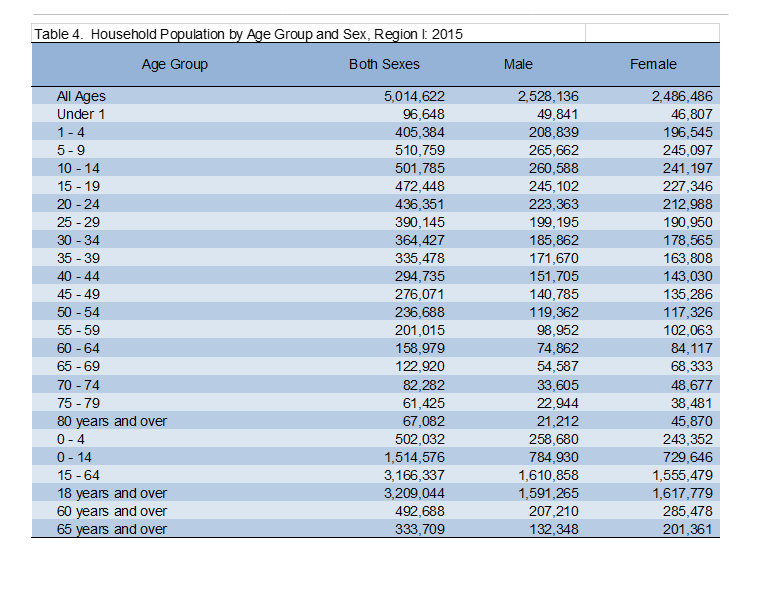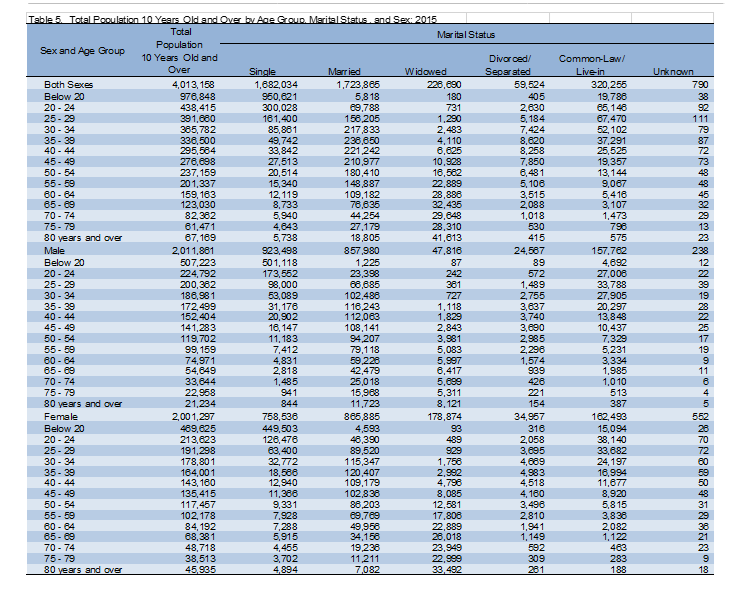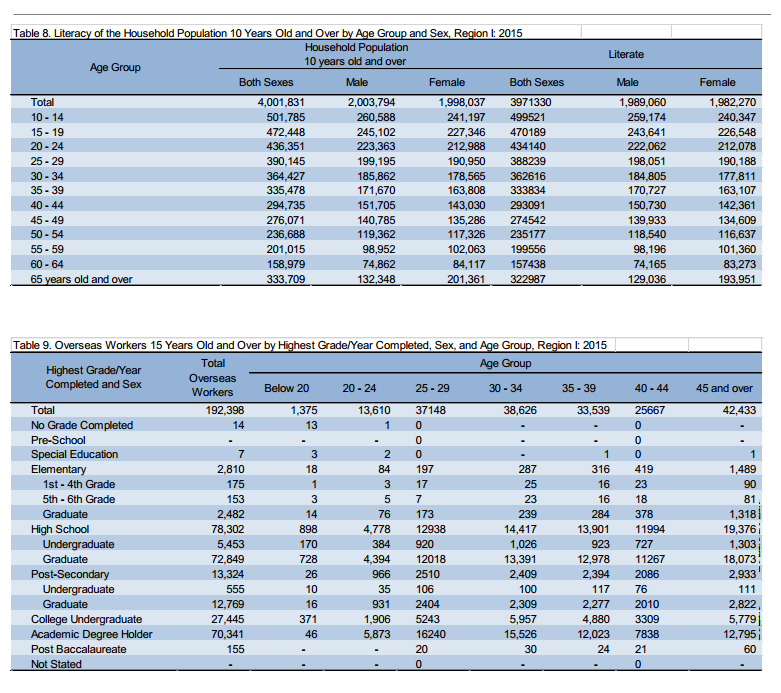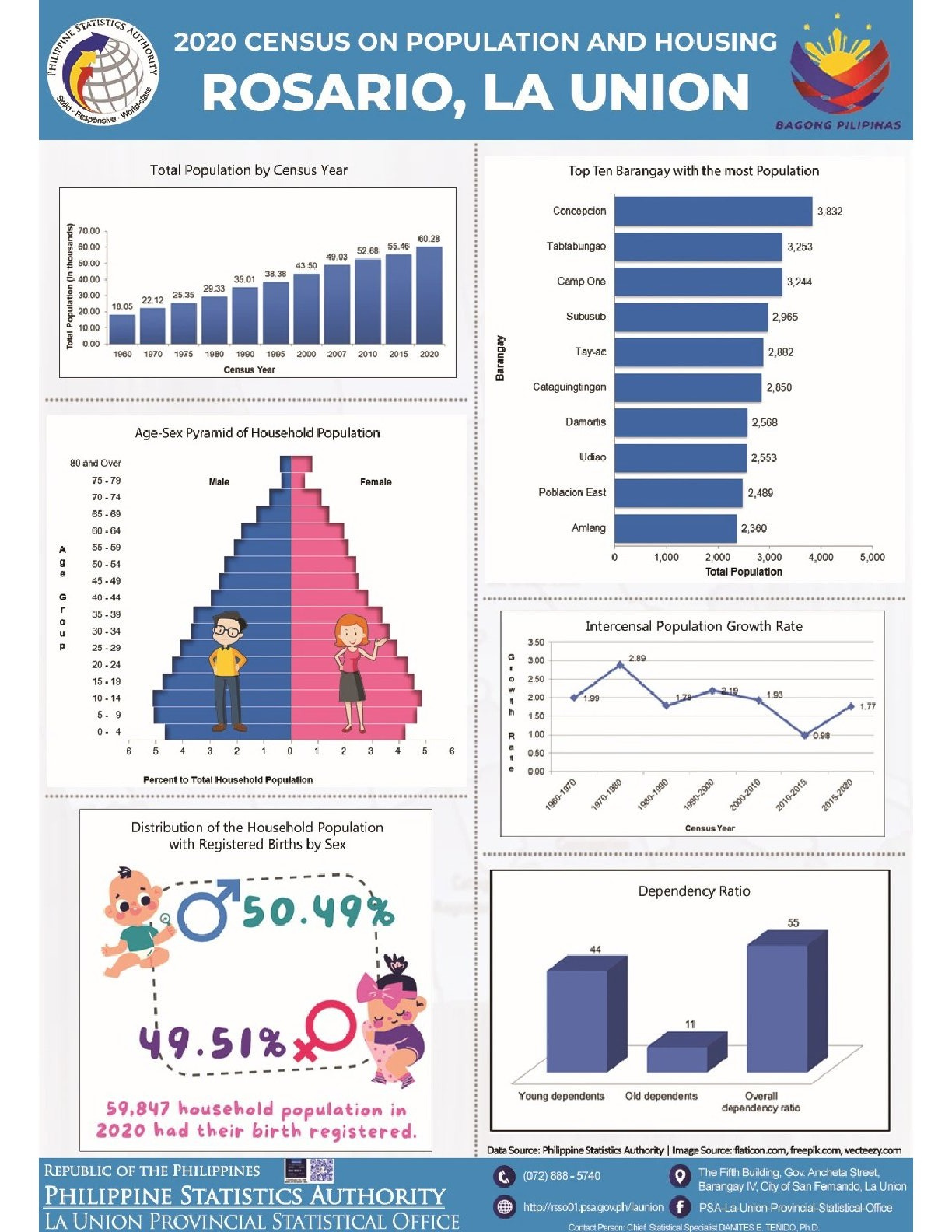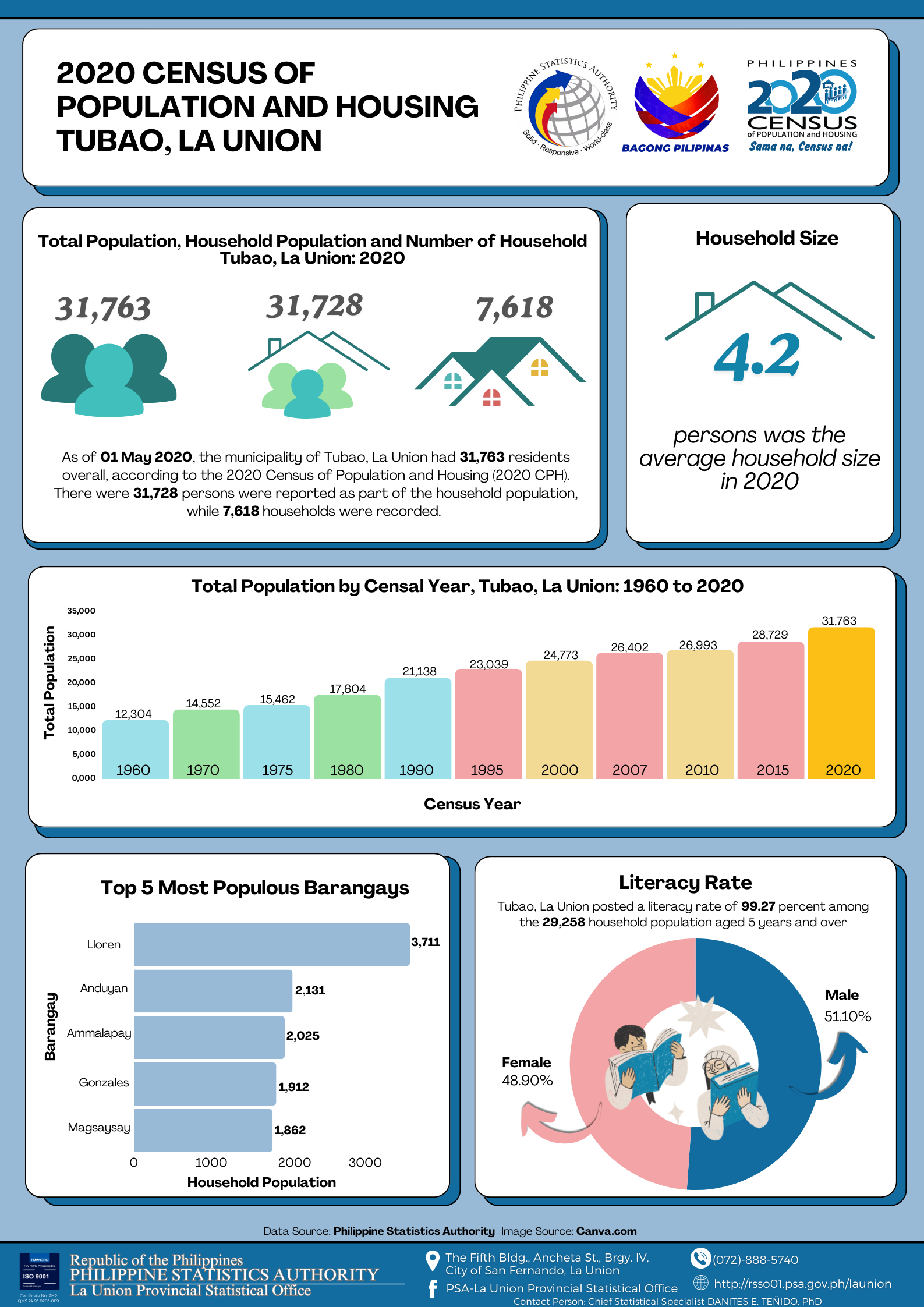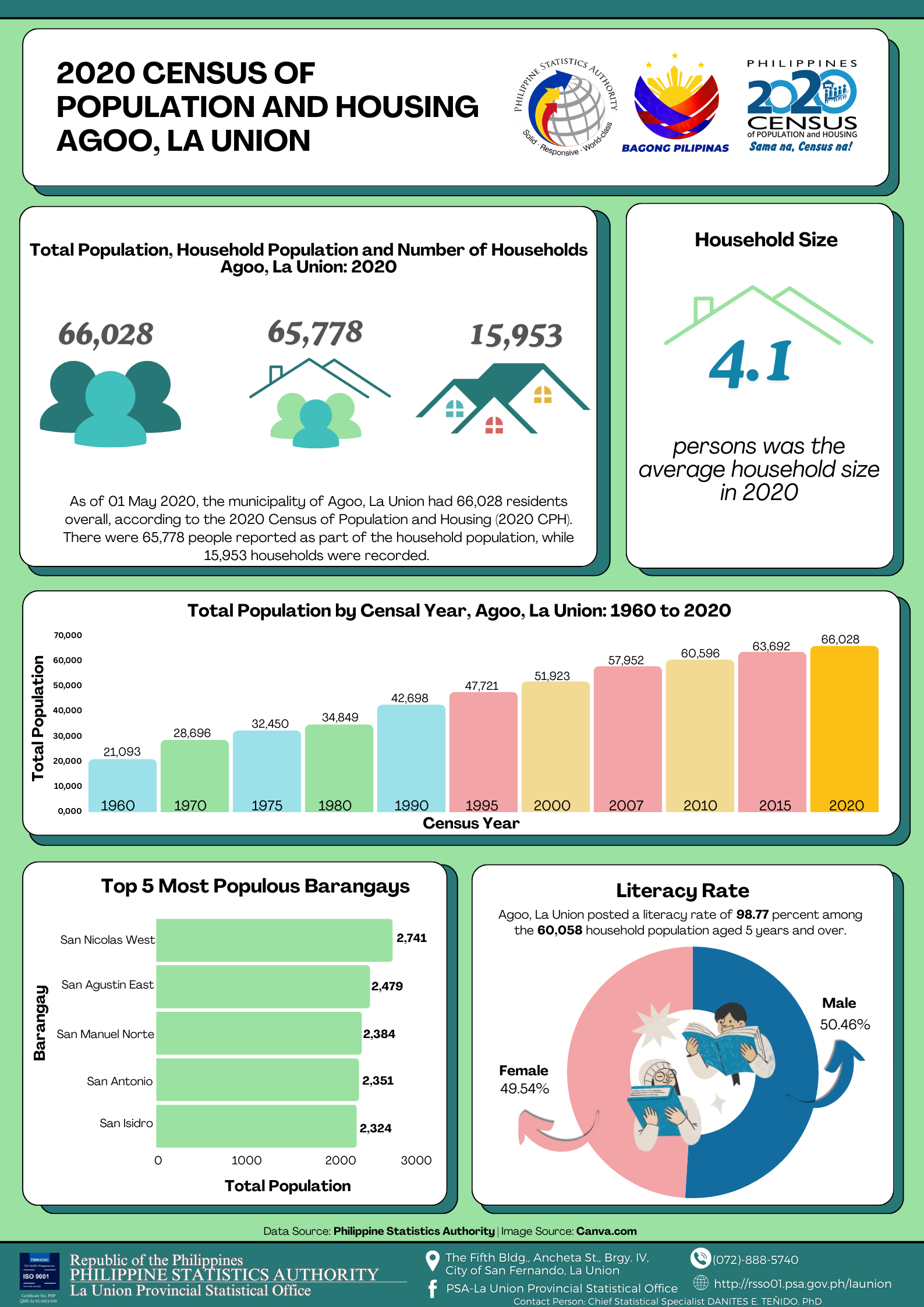Population increased at the rate of 1.09 percent annually
Based on the 2015 Census of Population (POPCEN), the region posted a total population of 5,026,128 persons as of August 1, 2015. This was larger by 277,756 persons compared to its total population of 4,748,372 persons counted in the 2010 Census of Population and Housing (CPH). The increase in the population count from 2010 to 2015 translated to an average annual population growth rate (PGR) of 1.09 percent. This was lower than the 1.23 percent annual PGR of the region between the census years 2000 and 2010.

Among the nine cities and 116 municipalities comprising the region, San Carlos City, located in the province of Pangasinan, was the most populous with a population size making up 3.75 percent of the total regional population. Dagupan City was second with 3.41 percent share, followed by City of Urdaneta with 2.64 percent, municipality of Malasiqui with 2.59 percent and City of San Fernando with 2.42 percent, the only area outside Pangasinan which was included in the five most populous cities/municipalities. Ranks sixth to ninth were the municipality of Bayambang (2.35 percent), Laoag City (2.21 percent), municipality of Mangaldan (2.12 percent) and municipality of Lingayen (2.05 percent). The rest of the cities/municipalities has a share of lower than 2.0 percent each.
The least populated area was the municipality of Carasi with 0.03 percent share to the total population of the region (1,567 persons). It was the least populated municipality in the region since 1960.

Pangasinan comprised more than half of the Region’s total population
Among the four provinces of the region, Pangasinan registered the largest population with 2,956,726 comprising 58.83 percent of the region’s total population. This was followed by La Union with 786,653 persons (15.65 percent) and Ilocos Sur with 689,668 persons (13.72 percent). Ilocos Norte registered the smallest population with 593,081 persons equivalent to 11.80 percent of the region’s total population.
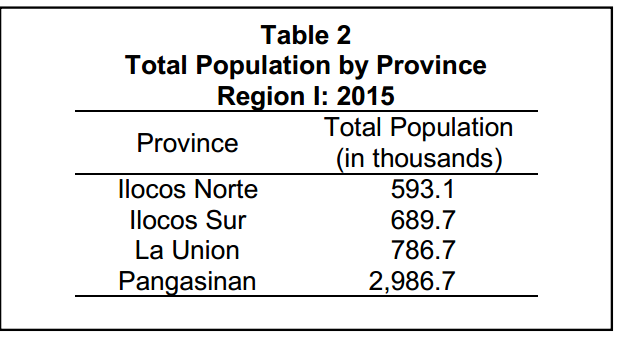
Sex ratio was 102 males per 100 females
Of the 5,014,622 household population in 2015, males accounted for 50.42 percent while females comprised 49.68 percent. These figures resulted in a sex ratio of 102 males for every 100 females, which was the same to the country’s recorded sex ratio.
Median age was 25.1 years
In 2015, the median age of the population in Region I was 25.1 years, which means that half of the population was younger than 25.1 years. The region’s median age was higher than the national median age of 24.3 years.
Moreover, three in every 10 persons (30.20 percent) were under 15 years old. Children aged 5 to 9 years (10.19 percent) comprised the largest age group, followed closely by those in the age groups 0 to 4 years (10.01 percent) and 10 to 14 years (10.01 percent). Males outnumbered females in the age groups 0 to 54 years. On the other hand, there were more females than males in the older age groups (55 years and over).
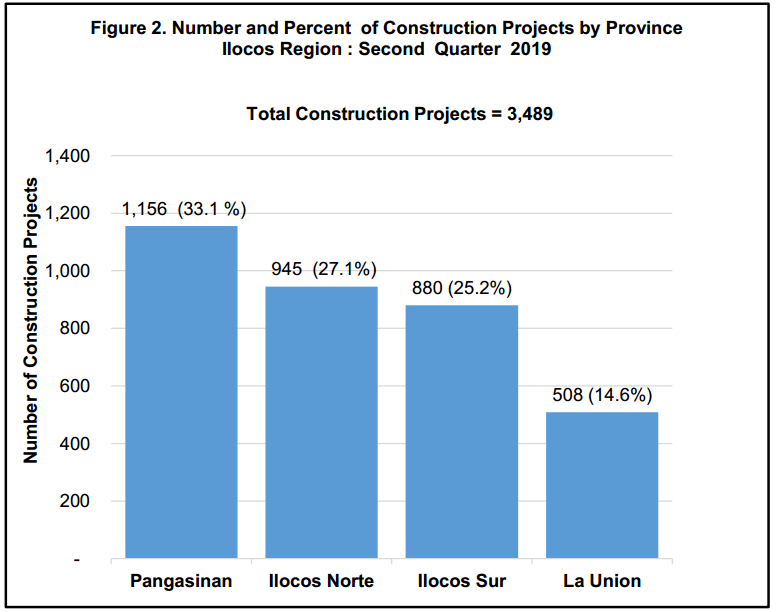
More Than half of the household population were of voting age
The voting-age population (18 years and over) accounted for 63.99 percent of the household population of the region in 2015. There were more females (50.41 percent) than males (49.49 percent) among the voting-age population.
Dependency ratio was 58 dependents per 100 persons in the working age group
In 2015, the young dependents (0 to 14 years) comprised 30.20 percent of the household population while the old dependents (65 years and over) posted a share of 6.65 percent. The working-age population (15 to 64 years) accounted for the remaining 63.14 percent.
The overall dependency ratio was 58, which indicates that for every 100 working-age population, there were about 58 dependents (48 young dependents and 10 old dependents).

About 43 percent of the household population 10 years old and over were married
Of the household population 10 years old and over, 43.00 percent were married while 41.85 percent were never-married. The rest of the population were reported as follows: widowed (5.66 percent), common-law/live-in marital arrangement (7.99 percent), and divorced/separated (1.49 percent).
Among the never-married persons, 50.07 percent were males while 49.93 percent were females. For the rest of the categories on marital status, females outnumbered the males.
More females than males completed academic degree and post baccalaureate courses
Of the population five years old and over, 29.13 percent attended or completed elementary education, 42.04 percent reached or finished high school, 9.64 percent were college undergraduates, and 11.68 percent were academic degree holders. Among those with an academic degree, females (57.22 percent) outnumbered the males (42.78 percent). Similarly, more females (63.37 percent) than males (36.63 percent) pursued post baccalaureate courses.
Literacy rate was posted at 99.24 percent
Of the household population age 10 years old and over, 99.24 percent were literate. Among those who were literate, males (50.09 percent) slightly outnumbered the females (49.91 percent). Majority of the literate individuals were aged 10-34 years old.
Seven in every ten school-age population currently attending school
Of the 1.9 million household population 5-24 years old, 69.53 percent were reported to be attending school. Of those persons reported to be attending school, 36.82 percent were aged 5-9 years, 36.55 percent aged 10-14 years, 22.38 percent aged 15-19 years, and the remaining 4.25 percent aged between 20-24 years.
Roman Catholics comprised 82.32 percent of the population in Region I
Among the household population in Region I, 4.1 million (82.32 percent) reported Roman Catholic as their religious affiliation.
The second largest religious affiliation in the region was the National Council of Churches in the Philippines, which accounted 3.86 percent of the household population. This was followed by the Iglesia ni Cristo with 3.46 percent and Philippine Council of Evangelical Churches with 3.11 percent.
Female overseas workers outnumbered that of males
Of the 3.5 million household population 15 years old and over in Region I, 5.50 percent were overseas workers. Female overseas workers outnumbered their male counterparts as they comprised 58.03 percent of the overseas workers from the region. Overseas workers aged 45 years and over made up the largest age group, comprising 22.05 percent of the total overseas workers from the region in 2015, followed by the age groups 30-34 years (20.08 percent), 25-29 years (19.31 percent) and 35-39 years (17.43 percent).
Average household size was 4.4 persons
The number of households in 2015 was recorded at 1.2 million with an average household size of 4.4 persons. Majority of the households in the region were reported to be with male household head.
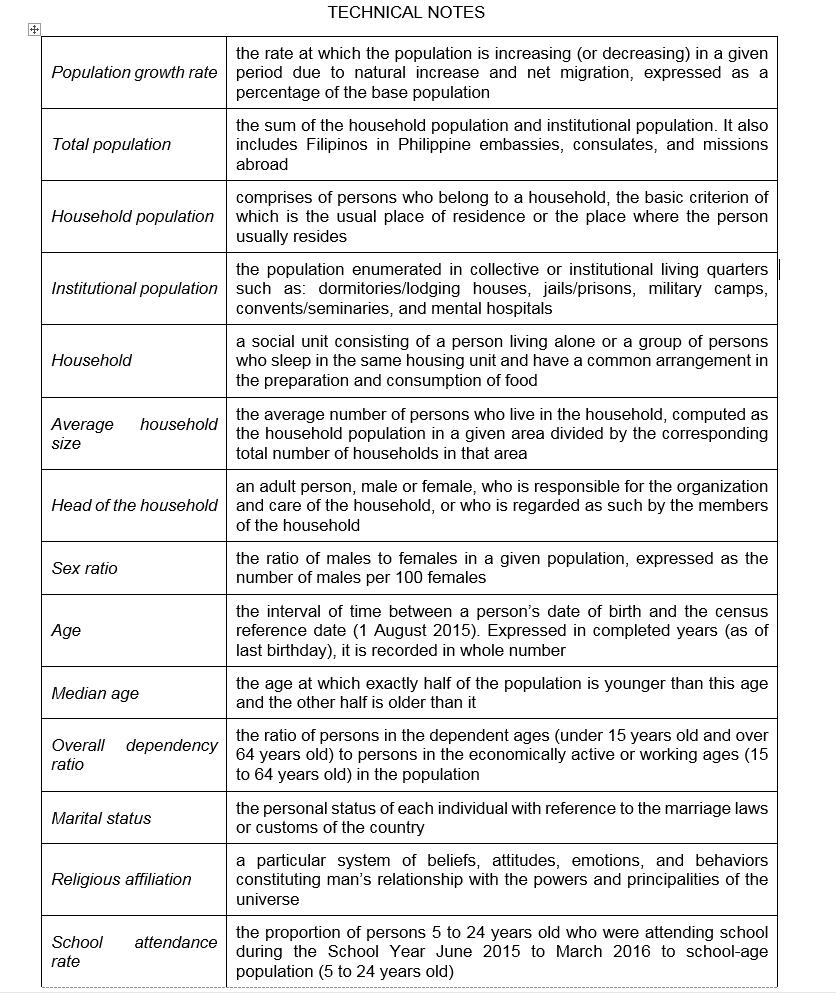

The 2015 Census of Population (POPCEN 2015) was undertaken by the Philippine Statistics Authority (PSA) in August 2015 as mandated by Republic Act No. 10625, ohterwise known as Philippine Statistics Act 2013. It was the 14th census of popualation that was undertaken sice the first census in 1903. POPCEN 2015 was designed to take an inventory of the total population all over the Philippines and collect information about thier characteristics. Census day for the POPCEN 2015 was August 1, 2015 (12:01 a.m). POPCEN 2015 made use of the de jure concept of enumeration wherein households and persons are enumerated in the area where they usually reside as of the census reference date. Enumeration lasted for about 25 days, from 10 August to 6 September 2015. Enumeration was extended until 15 September 2015 for large provinces and some highly urbanized cities.
